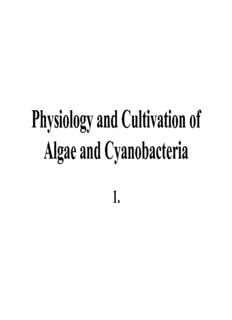
Physiology and Cultivation of Algae and Cyanobacteria PDF
Preview Physiology and Cultivation of Algae and Cyanobacteria
Physiology and Cultivation of Algae and Cyanobacteria 1. Definition • Algae formal tax. standing, polyphyletic origin, artificial assemblage of O 2 evolving photosynthetic organisms • Algae vs. Plants the same storage compounds, similar defence strategies against predators & parasites Plants Algae •hi degree of differentiation •don’t have roots, stems, leaves, not well defined •repr. organs surrounded by jacket of vasc. tissue •don’t form embryo sterile cells •mono- & digenetic life cycles •multicell. embryo remains •occur in dissimilar forms (micro algae, macro a. developmentaly & nutrit. independent multicellular, colonies, branched,…) on parents •less complexity of the thalli •meristems on root/shoot apices •hi diversity 0.2 – 60m •digenetic life cycles with alterations ecology & habitats betw. hapl. gametophyte & dipl. reserve & structural sporophyte polysacharides evolutionary origin •1 – 10 mil. species •½ primary production in biosphaera Klasification • under constant revision (Van Den Hoek et al. 1995) Occurrence & distribution Aquatic • almost everywhere (from freshwater spring to salt lakes) • tolerance of wide range of pH, temp., turbidity, O & CO conc. 2 2 • planctonic » unicellular, suspended throughout lighted regions of all water (inc. polar ice) • benthic » within sediments » limited to shallow areas (because of rapid attenuation of light with depth) » attached to stones –epilithic,on mud/sand –epipelic » on oteralgae/plants –epiphytic, on animals –epizoic • marine benthic – after habitat – supralitoral–above high-tide level within reach wave spray – intertidal–exposed to tidal cycles – sublitoral–from extreme low-water to cca200m deep • ocean – 71% of earth surface, more than 5000 spec. of planctonic algae – phytoplancton » base of marine food chain » produce 50% of O we inhale -life 2 » death –blooms –too large populations (decrease water transparency, prod. toxins & poisons) – kelps » giant algae –temperate pelagicmarine environment, till 60m submerged forests » also beneath polar ice sheet » can survive at very low depth – record of 268m u.s.l. – dark blue red algae (blue-green ligh, 0.0005% of surface intensity) » have accesorypigments, chanelthe energy to chla • accesory & protective pigments – give algae wide variety of colors <> names Occurrence & distribution Freshwater fytoplancton & benthic algae » base of aquatic food chain » not exhibit size range of marine relatives Subaerial » life on land » tree trunks, animal fur, snow, hot springs, desert rocks » activity – convert rock > soil − to minimize soil erosion & increase water retention & nutrient availability for plants Symbiosis • lichens, corals » to survive in environments that they could not alone Structure o thallus Unicells & unicell colonial algae • solitary cells, unicells with/w-out flagela, motile (Ochromonas)/non-motile (Nannochloris) • colony – aggregates of several single cells held together ±organized – grow – cell division – each cell can survive solely • coenobium – colony with number of cells & arrangement determined at the time of origin (e.g. Volvox – motile, Pediastrum – non-motile)
Description: